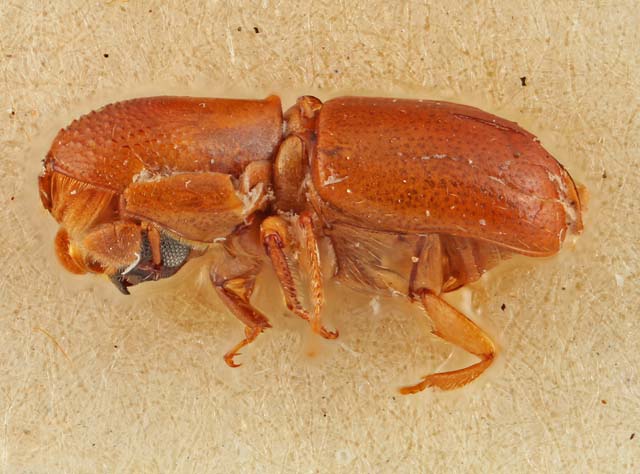Monarthrum costatum (Eggers 1937)


 Images: Displaying 1 to 8 of 9
Images: Displaying 1 to 8 of 9 




 Monarthrum costatum (female)
Monarthrum costatum (female) |
 Monarthrum costatum (female)
Monarthrum costatum (female) |
 Monarthrum costatum (female)
Monarthrum costatum (female) |
 Monarthrum costatum (female)
Monarthrum costatum (female) |
 Monarthrum costatum (male)
Monarthrum costatum (male) |
 Monarthrum costatum (male)
Monarthrum costatum (male) |
 Monarthrum costatum (male)
Monarthrum costatum (male) |
 Monarthrum costatum (male)
Monarthrum costatum (male) |
| Next > |

Monarthrum costatum (female) (by SM Smith, Michigan State University). paralectotype Brachyspartus costatus Eggers. This image is the property of the National Museum of Natural History, Smithsonian Institution, Washington, D.C., used under CC0 license
 Summary of Information
Summary of Information





SYNONYMY
Taxonomic Comments. Eggers described this species from 3 syntypes: a male and female on the British Museum and a male specimen kept in his own collection. The verbatim text translates as 'Types (male, female( in British Museum, male cotype in my collection..". By standards of the ICZN these are all syntypes given that cotype has never had any status within the code other than as syntype or paratype. Given that Eggers did not explicitly designate a single specimen, all 3 have equal status in nomencalture. Anderson & Anderson (1971: 10) designated the male specimen from Egger's collection as the lectotype, thereby conferring the status of paralectotypes on the specimens in the Britsih Museum. Wood & Bright (1992: 1063) disregarded the action by Anderson & Anderson and cited "syntypes" in the BMNH. Wood (2007: 754) cited the male paralectotype in the BMNH as the 'holotype' which is totally without any basis. Anderson & Anderson's original lectotype designation is correct.
- Monarthrum costatum (Eggers 1937) Rev. Entomol. Rio Jan. 7(1): 85
- Brachyspartus costatus Eggers 1937. Rev. Entomol. Rio Jan. 7(1): 85
DISTRIBUTION.
Numbers in parentheses after each geographic unit are the number of distinct collection events in the database for that unit. For exotic species generally only countries are listed for localities outside the New World. For further information on published sources of distribution, check the REFERENCES section.
- South America (5)
Brazil (2): Bahia (1), Mato Grosso (1); Perú (3): Cusco (1), Madre de Dios (2);
HOSTS
Numbers in parentheses after each host family, genus, or collection method are the number of distinct collection events in the database for that host or method.
- No host information (1);
- Burseraceae (1): Protium (1): sp. (1);
- Malvaceae (1): Theobroma (1): cacao (1);
- trap (2) flight intercept (2): no details (2);
REFERENCES
The following are important recent monographs, catalogs, and supplements to catalogs that refer to this species. The specific page on which the reference is made is shown in pink at the end of the reference. In the case of Wood (1982) and Wood & Bright (1992) clicking on the reference page will link to a digital version of the work in question.
- Wood, S.L., Bright,D.E. 1992. A catalog of Scolytidae and Platypodidae (Coleoptera), Part 2. Taxonomic Index. Great Basin Nat. Mem. 13:1-1553 (vol. A, B). [1053]
- Wood, S.L. 2007. Bark and ambrosia beetles of South America (Coleoptera: Scolytidae). Monte L. Bean Sci. Mus.,Provo, Utah. 900 pp. [754]. (data capture complete)
The following are references from which host and distribution data have been input into the database. If one of the above monographs or catalogs also appears in this list, it means that most relevant collection event data have been included.
- . . .
- Smith, S.M.; Petrov, A.V.; Cognato, A.I. 2017. Beetles (Coleoptera) of Peru: A Survey of the Families. Curculionidae: Scolytinae. Coleopterists Bull. 71(1): 77-94.
- Wood, S.L. 2007. Bark and ambrosia beetles of South America (Coleoptera: Scolytidae). Monte L. Bean Science Museum. Provo, Utah: 1-900.
- Wood, S.L.; Bright, D.E. 1992. A catalog of Scolytidae and Platypodidae (Coleoptera), Part 2. Taxonomic Index (Volumes A,B). Great Basin Nat. Mem. 13: 1-1553.
 Distribution Map
Distribution Map





Maps automatically open at the center of the plotted points and the scale is set to encompass all map points. Maps can be resized (scale bar at upper left) and the center moved (place cursor over map and drag) to see other parts of the distribution of the species. Clicking on a map marker will pull up collection event data and a literature citation if present. If any errors are found, please refer to the "series code" which is a unique identifier for a database record in any communications). Coordinates have not been entered for all collection records. Localities outside the New World are not plotted, even though they are listed in the distribution summary and in the table of records.
 Collection Records
Collection Records





| No. | Collection data | Publication |
|---|---|---|
| South America | ||
| 1-> | Brazil, Bahia, Bahia (estado); 1935; Bellairs, A.F.; Malvaceae: Theobroma cacao | [USNM (1: lectotype, male) (Anderson, W.H.; Anderson, D.M. 1971: 10)] [BMNH (1: paratype(s), male) (Wood, S.L.; Bright, D.E. 1992: 1053) (Wood, S.L. 2007: 754) (Anderson, W.H.; Anderson, D.M. 1971: 10)] [BMNH (1: paratype(s), female) (Anderson, W.H.; Anderson, D.M. 1971: 10)] |
| 2-> | Brazil, Mato Grosso, Xavantina, 260 km N; 23/XI/1968; Beaver, R.A. | [unknown (1) (Wood, S.L. 2007: 754)] |
| 3-> | Perú, Cusco, Villa Carmen Filed Station; Bennet, D.J.; Razuri, E.; trap: flight intercept | [SEMC (3) (Smith, S.M.; Petrov, A.V.; Cognato, A.I. 2017: 80)] |
| 4-> | Perú, Madre de Dios, CICRA Field Station; Chaboo team; trap: flight intercept | [SEMC (1) (Smith, S.M.; Petrov, A.V.; Cognato, A.I. 2017: 80)] |
| 5-> | Perú, Madre de Dios, Los Amigos Biological Station; Smith, S.M.; Hulcr, J.; Burseraceae: Protium sp. | [MSUC (6) (Smith, S.M.; Petrov, A.V.; Cognato, A.I. 2017: 80)] |
Return to top of page
